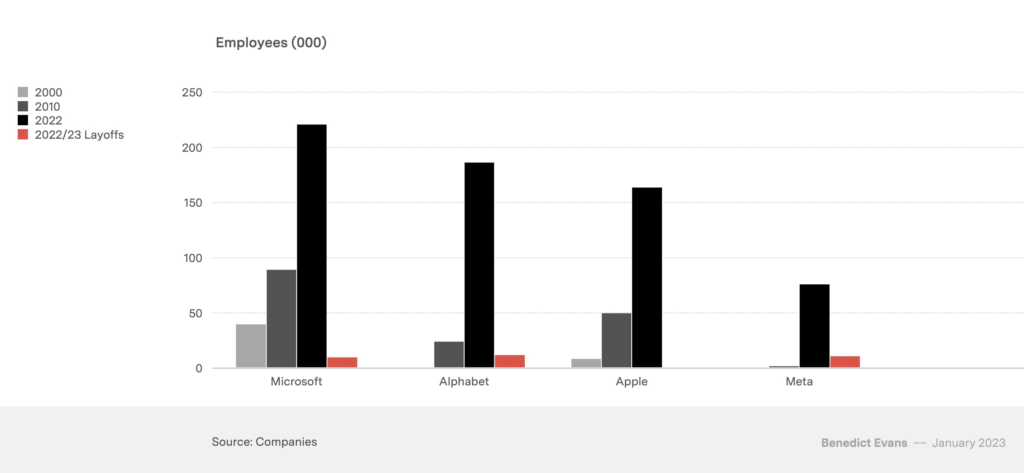Cutting costs and jobs at Google has a second bottom – the giant is facing a clash with AI tools, which pose a real threat to the search engine. Despite the large wave of layoffs in IT, let’s remain calm. Although the layoffs affect many people, there are still hundreds of thousands of specialists working in Big Tech, and IT experts are quickly finding new jobs.
1. Google: Layoffs and questions about the future
Google has followed in the footsteps of Meta, Amazon, Twitter and several other giants. Last week, 12,000, or about 6% of the entire team, said goodbye to the company. These are the largest layoffs in Google’s history, and (probably) the decisive stage of cost-cutting that began six months ago.
It will be recalled that the reduction included a number of projects and teams: the laptop division was closed, Project Loon was split off, the Area 120 “idea incubator” was halved, the Google Stadia project was closed, investment in Google Assistant was reduced, the Waze and Google Maps teams were merged, and several percent of full-time positions at Verily and Intristic were cut. Google CEO Sundar Pichai said that company’s productivity was “not where it needs to be”. And where should it be? You probably already know the answer.

Google has a huge challenge ahead with ChatGPT and other AI-supported tools. The rapid growth of these services threatens the search engine, Google’s flagship product, which generated $148.8 billion (58% of the company’s revenue) in 2021. This makes it all the more surprising that Google was so late in realizing the power of AI rivals and simply slept through the moment when it should have worked on its own chatbot.
A drowning man will clutch at a straw or at least call for support on board. Google has sent a clear SOS signal, to which two nearby ships – Larry Page and Sergey Brin – have responded. Will they help change course before the unsinkable Google smashes into the iceberg with the OpenAI logo? We’ll find out soon enough.

Sources:
- https://arstechnica.com/gadgets/2023/01/google-cuts-12000-jobs-the-largest-layoff-in-the-companys-history/
- https://techcrunch.com/2023/01/20/area-120-googles-in-house-incubator-severely-impacted-by-alphabet-mass-layoffs/
- https://www.businessinsider.com/google-larry-page-sergey-brin-help-chatgpt-code-red-2023-1?IR=T

2. Let’s calm down in the face of layoffs
The giants are laying people off, but should we ordinary professionals fall into a gloomy mood? Not necessarily. It’s hard to pass over a situation in which tens of thousands of people have to say goodbye to their dream jobs, but it’s worth looking at the bigger picture, completely in the cold.
First, we must not forget that there are hundreds of thousands of people working in Big Tech. On this scale, layoffs are not THAT gigantic, although still very painful.

Secondly, those laid off from large corporations are doing quite well. It’s not as good as the famous maxim: “Unemployment is the worst half hour of a programmer’s life,” but according to a survey conducted by ZipRecruiter – 80% of those laid off find a new job in IT within 3 months.
Third, the media is stoking a layoff panic that is particularly affecting young professionals. Meanwhile, what shocks millenials and Generation Z is nothing new for today’s 50-year-olds. In an article published by the New York Times, you’ll find memories of past crises, which I could summarize with a statement from one of the article’s main characters: “The shame of being laid off is gone. Companies know that a lot of good people are being laid off these days.”

Fourth, still not all companies intend to say goodbye to a large part of their specialists. A perfect example is Apple, which for the time being is emerging from the crisis with no PR damage. I hope I won’t have to retract this in a week’s time, but while Big Tech was growing its workforce at an astronomical rate, Apple was severely restrained and grew by “only” 20% during the pandemic. What follows is that, for now, there are no symptoms of overhiring in the company.
LAST BUT NOT LEAST
Spotify will be laying off this week, but it is not yet clear how much of its team. The situation is dynamic.
Source:
- https://twitter.com/benedictevans/status/1616612218480590848
- https://www.investopedia.com/tech-workers-find-jobs-7089808#:~:text=Key%20Takeaways,inflation%20and%20interest%20rate%20hikes.
- https://www.nytimes.com/2023/01/20/technology/tech-layoffs-millennials-gen-x.html
- https://www.wsj.com/articles/how-apple-has-so-far-avoided-layoffs-lean-hiring-no-free-lunches-11674274185
- https://www.bloomberg.com/news/articles/2023-01-23/spotify-seen-cutting-staff-as-soon-as-this-week-to-cut-costs?leadSource=uverify%20wall

3. It’s time for Scrum without a Master
Finally, I would still like to refer to the previous edition of Career Weekly, in which I reported that difficult times are coming for non-technical managers. Those were predictions then; today I have the first evidence.
Capital One is perhaps the first company to announce in one breath that it is laying off a thousand people and changing its approach to Agile. From now on, teams working in this methodology are to be more tightly integrated with pre-existing departments, led by engineers and product managers. The matter was commented on by a company spokesperson, who assessed that Agile was useful at earlier stages of the company’s development, but that it is now crucial for the organization to work within core engineering teams.

In short: Agile remains, but… it’s not the same anymore. It will be worked on mainly by programmers, while other teams will use selected elements of this methodology, led by managers specializing in specific areas.
Of course, I will continue to look at this arch-interesting trend. Without meaness and out of journalistic duty!




